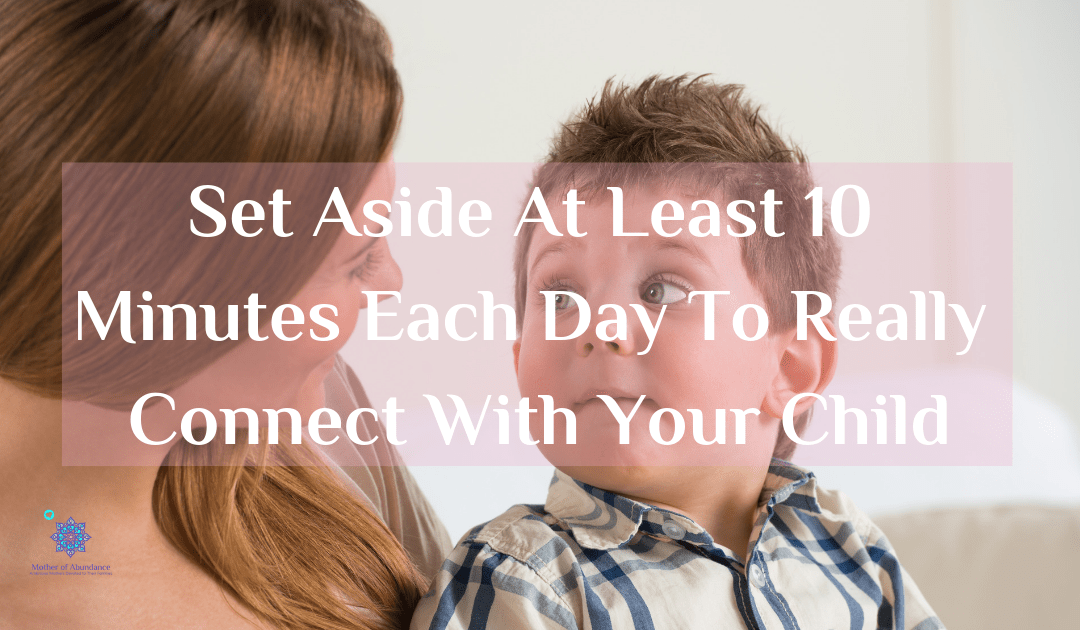A Mother of Abundance is connected to her children. She maintains this connection by using focused attention. Your task on Day 8 of the 28 Day Abundant Practice Challenge is to set aside at least ten minutes each day to really connect with your child.
When I was a young mum, I remember reading that I should have focused contact with my child for at least 10mins every day. I think I laughed out loud when I read it! I was a single parent doing a full-time degree and felt like I was focussing in a very intense way with my young son already. I was either washing him, dressing him, feeding him or taking him to/from nursery. I thought, if that isn’t focussed attention, I didn’t know what was!
It seemed like a none stop conveyor belt of activities surrounding my son and study with very little time left over for anything else. I feel exhausted just looking back at that period in my life. Where was I going to find yet another ten minutes to fit into my jam-packed day?
Luckily, I continued reading the book and went on to discover that doing things for my son wasn’t what the book was trying to describe. Even though I found changing my parenting routine a little bit intimidating, I was willing to try because I wanted to be the best mother I could be in spite of my stressful circumstances.
That book is long gone now, but I never forgot it’s sentiment. I’ve used it with all four of my sons when they’ve come home from nursery/school/college/uni/work.

The basics of exactly how I connected with them are covered really well in this article by Time Magazine called 7 Powerful Tips for Great Parent-Child Communication. I’ve quoted a section below:
1. Talk during the in-betweens.
What were you doing the last time you had a good conversation with your child? I know the answers: walking or driving to school, baking together, bath time, and, of course, bedtime. These times and activities loosen tongues because parent and child aren’t looking at each other. In fact, we are in parallel position. Most of us think talking is supposed to be about relating deeply, but kids actually open up in the middle of doing other things, during what I refer to as the “in-betweens” of life.
2. Create talking rituals.
Observe your child’s conversational style. You’ve heard about learning or attentional styles, but our kids have hard-wired conversational styles that don’t change much. One child may be a lively morning talker. Another is barely human before the bus arrives, but after school it’s no-holds-barred banter. One of your children likes a lot of back and forth, another needs to talk at a slower pace, a third can’t tolerate questions. The key to openness is to not change what is unchangeable, but instead to respect natural times and ways of talking. Build what I call “talking rituals” around them: 15 minutes of driving together or downtime side-by-side in the evening may be all you need to make that connection.
3. Be a person.
Respond to your child with real emotion. Don’t go over the top with reactions, but don’t be a therapist either. Nodding one’s head, naming feelings, and reflecting back is terrific when kids are extremely young or upset or sick or scared. But for the everyday tracking we need to stay in touch with their lives, it is far better to respond like an actual person. “Are you kidding me, Michael did what to Earnest?” “I love what you said to Jenny, it touches my heart.” After all, don’t genuine responses make you want to share more too?
4. Encourage emotional literacy.
Help your kids tell the story. We focus on academics, but our kids also need to be emotionally literate, able to tell a story from beginning to end. Problems are better solved when one can articulate them to another person and people find solutions together. I know, kids take so long to get to the point and schedules must be followed. But slow down for two minutes to ask action questions: “Who was there? What did they say? What happened next?” These help your child feel heard and show you are interested in the whole story. “Love is focused interest,” it has been said, and our kids can tell when we are interested in the story. As a 6-year-old said to me, “I want mom’s undivided attention.” “What do you mean, no siblings around?” “No,” she replied,” not thinking about 50 other things at once.”
5. Details matter.
Pay attention to the superficial. “You lost quarters under the vending machine. What year were they?” often leads to the real scoop. “I was at the vending machine because I didn’t think anyone would talk to me at lunch.” The trivial is where kids live; they get scared off when we delve for deeper feelings, as in “How did that make you feel?” So, commit to the superficial, and more often than not the trivial will lead to what’s really going on.
6. You count, too.
This is big in our child-centered world. Talk about yourself if you want your kids to talk about themselves. Next time at dinner, spend a few moments opening up about your day. Your child will interrupt, and I guarantee you won’t get to the end of the story. The reason it’s such a conversation trigger is that when you talk about yourself it reminds kids about things in their distant memory three hours earlier. For example, if you say, “I had an argument with one of my friends at work,” your child might well respond, “I had a fight with Jenny during gym.” And a special note about dinnertime: grill the food not your kids. Endless queries such as “How was school?” are conversation-busters. As one pre-teen told me, “It feels like I have to produce all over again at dinner.”
7. Give advice.
It’s hard to believe, but our precocious 21st Century kids of all ages still crave direction. After the story, after you’ve responded, then discuss together how your child might handle the situation differently next time. Ask for her ideas, and don’t be afraid to give yours. Try not to lecture, and pay attention to those subtle signals of going on too long. Keep it short, and use your life-wisdom to guide. Begin with, “I know my experience isn’t anything like yours, it’s very different now,” since even young children need to feel separate enough to discover what works. Powerful advice means recognizing your own limits to help kids make decisions without you. Tell them, “I can’t be there to make the decision about sharing that toy or sharing that secret with Joanne, but here’s what I think will happen.” When children know where you stand, they feel closer to you and more willing to open up.
You can read the entire post here.
My sons’ ages range from seven to 25. I recommend you try this form of direct engagement with your child irrespective of their age, as long as it’s done in a way that’s age-appropriate.
[click_to_tweet tweet=”My sons’ ages range from seven to 25. I recommend you try this form of direct engagement with your child irrespective of their age, as long as it’s done in a way that’s age-appropriate. ” quote=”My sons’ ages range from seven to 25. I recommend you try this form of direct engagement with your child irrespective of their age, as long as it’s done in a way that’s age-appropriate. “]
I’ve found that practising this with my sons has led to very close relationships and a demonstration of a deeper need to connect with them.
What about you? Do you communicate with your child in a way that stretches them in an age-appropriate way? Do you discuss things with them that serves to have a better understanding of them and their world from their perspective? Is this something you already do, or do you find that your conversations are mainly task focused? Please share your thoughts below.
For further reading, check our resources page.
Comment on social media with the hashtag #28daysofabundance, join the facebook group here: https://www.facebook.com/groups/motherofabundance/ Feel free to invite other ambitious mothers to the group.
This post and the 28 Day Abundant Practice Challenge are inspired by the principles in the 9 Steps to True Abundance infographic. You can get your free copy by signing up here.


